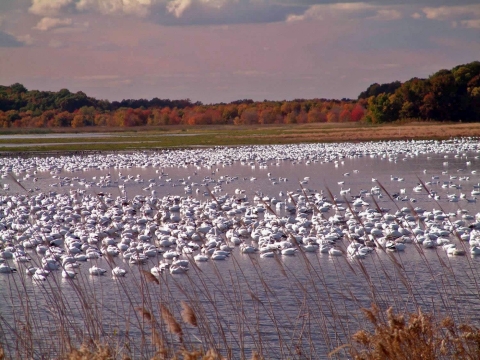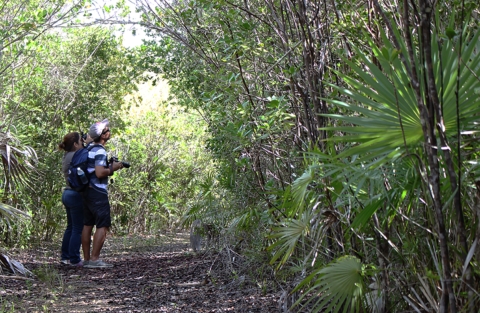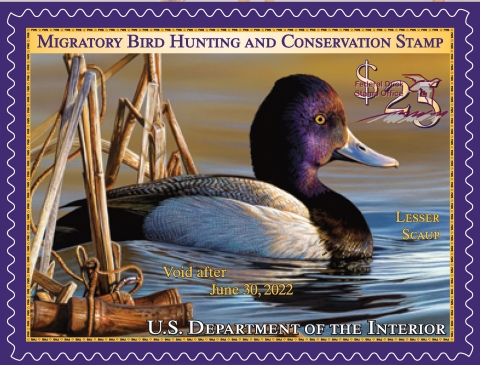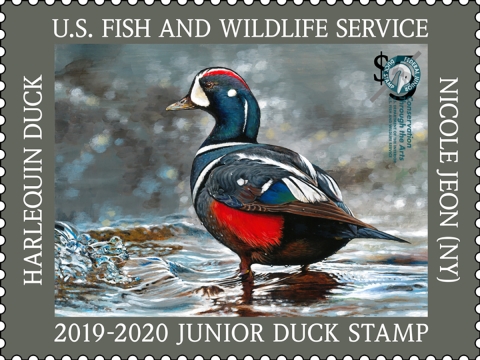Every June, hunters, birders, conservationists and stamp collectors celebrate the sale of the new Federal and Junior Duck Stamps. These stamps are part of waterfowl hunting license requirements; this means every hunter over the age of 16 must purchase and carry a valid annual Duck Stamp with them if they hunt ducks, geese, swans, and other migratory birds. These stamps are so much more than just a hunting stamp though, they are also collectible works of art and an easy way for everyone to support wetland conservation!
Here are some reasons why YOU should put your stamp on conservation and purchase a Duck Stamp annually!
1. The Federal Duck Stamp is one of the most successful conservation programs in the country. The Federal Migratory Bird Hunting and Conservation Stamp (commonly known as the Federal Duck Stamp) was born in the Dust Bowl Era when President Franklin D. Roosevelt signed the Migratory Bird Hunting Stamp Act in 1934 to conserve wetlands that are vital to the survival of migratory waterfowl. Since that first stamp, sales have raised more than $1.1 billion (that’s billion with a B!) to conserve more than 6 million acres of wetlands habitat.
2. Funds go directly to conserve wetland habitat for all of us to enjoy. Over 98% of the money raised from the sale of Duck Stamps goes directly to help acquire wetlands and conservation easements for the National Wildlife Refuge System. These wetlands and easements benefit a countless number of species and are important for humans too. Wetlands acquired with Duck Stamp dollars help purify water, aid in flood control, reduce soil erosion and sedimentation and enhance outdoor recreation opportunities.
3. Federal Duck Stamps are a free-pass to National Wildlife Refuges. A current Federal Duck Stamp is a free pass into any national wildlife refuge that charges an entry fee. The result: birders, nature photographers and other outdoor enthusiasts buy Duck Stamps to help ensure they can experience wildlife at their favorite outdoors spots. Since the National Wildlife Refuge System has at least one refuge in every state and territory, there are numerous opportunities for people to enjoy these outdoor spaces.
4. The Duck Stamp is a treasured collector’s item. Every year the U.S. Fish and Wildlife Service holds a public art contest to select the stamp design. Artists from across the nation compete for their entry to become the next stamp. The resulting stamp is a miniature work of art and a treasured item for stamp collectors around the world. More than 80 years in the making, the Duck Stamp is the longest-running single themed U.S. stamp, adding to its unique collectability. Duck Stamp artists enhance their reputation as wildlife conservationists and artists through the sale of prints and original artwork.
5. The Junior Duck Stamp Program is building a legacy of conservation. The Junior Duck Stamp Program is a year-long educational program that encourages K-12th grade students to learn about wetlands and waterfowl conservation, explore their natural world, and then create a painting or drawing of a duck, goose or swan to demonstrate what they learned. Local youth compete for recognition and the winning entry at the National Junior Duck Stamp Art Contest is also made into a stamp offered for sale to the public. Proceeds support conservation education at the state and local level. Since the first Junior Duck Stamps went on sale in 1993, well over $1 million has been raised, which has been re-invested in this unique conservation arts and science education program.
Purchasing Federal Duck Stamps and Junior Duck Stamps is very easy! We offer a variety of methods for you to purchase the annual stamps – whether you need one for migratory bird hunting, admittance to a national wildlife refuge national wildlife refuge
A national wildlife refuge is typically a contiguous area of land and water managed by the U.S. Fish and Wildlife Service for the conservation and, where appropriate, restoration of fish, wildlife and plant resources and their habitats for the benefit of present and future generations of Americans.
Learn more about national wildlife refuge , as part of your stamp or art collection, showcasing different wildlife species, or because you just want an easy and effective way to support habitat conservation and wildlife education.









